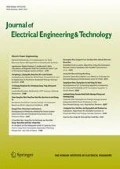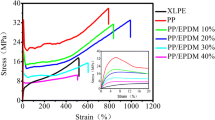Abstract
Due to the complicated structure composed of different kinds of materials, space charges tend to accumulate within cable accessories, which easily leads to the electrical breakdown. To obtain insights into the space charge accumulation in cable accessories, accelerated aging was performed for 10 kV crosslinked polyethylene (XLPE) insulated cable samples with stress cones, under an AC voltage of 26.1 kV and temperatures of 103 °C and 114 °C. The space charge distribution in the cable insulation was tested at different aging stages. The results show that space charge accumulates in the insulation covered by the stress cones, and the charge density and coaxial distribution region increase during aging. Together with the results for the charge measurement on peeled cable samples, it is concluded that charge accumulation is related to the semiconductor used in the stress cones. It is difficult for the space charge generated in the cable insulation to escape through the silicone rubber-based (SR-based) semiconductor in the stress cones, as the ability of this material to conduct charges is lower than that of a cable-shielding ethylene–vinyl acetate-based (EVA-based) semiconductor; therefore, the space charge accumulates near the outer part of the insulation. This research provides insights into the important function of semiconductor on charge accumulation in cable accessories, which will aid in research on optimizing and prolonging the lifetime of cable accessories.









Similar content being viewed by others
References
Zha J, Zhu Y, Li W et al (2012) Low dielectric permittivity and high thermal conductivity silicone rubber composites with micro-nano-sized particles. Appl Phys Lett 101:062905
Li J, Boxue Du, Kong X et al (2017) Nonlinear conductivity and interface charge behaviors between LDPE and EPDM/SiC composite for HVDC cable accessory. IEEE Trans Dielectr Electr Insul 24:1566–1573
Li Z, Boxue Du, Yang Z, Li J (2017) Effects of crystal morphology on space charge transportation and dissipation of sic/silicone rubber composites. IEEE Trans Dielectr Electr Insul 24:2616–2625
Song S, Li Z, Zhao H et al (2017) Electric field control in DC cable test termination by nano silicone rubber composite. AIP Adv 7:10–15
Chen G, Zhiqiang Xu (2009) Charge trapping and detrapping in polymeric materials. J Appl Phys 106:123707
Teyssedre G, Vu TTN, Laurent C (2015) Negative differential mobility for negative carriers as revealed by space charge measurements on crosslinked polyethylene insulated model cables. Appl Phys Lett 107:252901
Li J, Boxue Du, Hang Xu (2017) Suppressing interface charge between LDPE and EPDM for HVDC cable accessory insulation. IEEE Trans Dielectr Electr Insul 24:1331–1339
Kai Wu, Cheng C (2017) Interface charges between insulating materials. IEEE Trans Dielectr Electr Insul 24:2633–2642
Fleming RJ, Henriksen M, Holboll JT (2000) The influence of electrodes and conditioning on space charge accumulation in XLPE. IEEE Trans Dielectr Electr Insul 7:561–571
Lv M, Zhang Y, An Z, Zheng F (2016) Experiment on impact of surface fluorinated semiconductor electrode on space charge injection of polyethylene upon high direct voltage condition. In: IEEE int. conf. dielectr. (ICD), pp 211–214
Lisowski M, Skopec A (2009) Effective area of thin guarded electrode in determining of permittivity and volume resistivity. IEEE Trans Dielectr Electr Insul 16:24–31
He D, Jiefeng Gu, Wang W et al (2017) Research on mechanical and dielectric properties of XLPE cable under accelerated electrical-thermal aging. Polym Adv Technol 28:1020–1029
He D, Wang X, Liu H et al (2018) Space charge behavior in XLPE cable insulation under ac stress and its relation to thermo-electrical aging. IEEE Trans Dielectr Electr Insul 25:541–550
Wang X, Wang C, Kai Wu et al (2014) An improved optimal design scheme for high voltage cable accessories. IEEE Trans Dielectr Electr Insul 21:5–15
Wei Z, Hou Y, Jiang C et al (2019) Graphene enhanced electrical properties of polyethylene blends for high-voltage insulation. Electron Mater Lett 15:582–594
He D, Wang W, Jian Lu et al (2016) Space charge characteristics of power cables under AC stress and temperature gradients. IEEE Trans Dielectr Electr Insul 23:2404–2412
Das S, Gupta N (2015) Effect of ageing on space charge distribution in homogeneous and composite dielectrics. IEEE Trans Dielectr Electr Insul 22:541–547
Boufayed F, Teyssèdre G, Laurent C et al (2006) Models of bipolar charge transport in polyethylene. J Appl Phys 100:826–856
Acknowledgements
The authors wish to thank for the financial support from National Natural Science Foundation of China (Grant No. 51907105 and No. U1966209) and Shandong Provincial Natural Science Foundation (Grant No. ZR2019QEE013).
Author information
Authors and Affiliations
Corresponding author
Additional information
Publisher's Note
Springer Nature remains neutral with regard to jurisdictional claims in published maps and institutional affiliations.
Rights and permissions
About this article
Cite this article
He, D., Gong, W., Zhang, T. et al. Space Charge Accumulation Mechanism Near the Stress Cone of Cable Accessories Under Electrical-Thermal Aging. J. Electr. Eng. Technol. 16, 443–448 (2021). https://doi.org/10.1007/s42835-020-00543-1
Received:
Revised:
Accepted:
Published:
Issue Date:
DOI: https://doi.org/10.1007/s42835-020-00543-1




